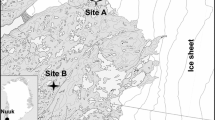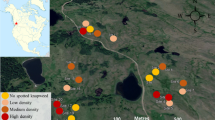Abstract
The organization of ecological communities along local environmental gradients provides important information about how such communities may respond to environmental change. In the Arctic, the importance of gradients in shrub cover and soil moisture for non-marine arthropod communities has been clearly demonstrated. By replicating studies along shrub and moisture gradients at multiple elevations and using space-for-time substitution, it is possible to examine how arthropod communities may respond to future environmental change. We collected and identified 4640 adult specimens of spiders and beetles near Narsarsuaq, South Greenland between 8 July and 25 August, 2014 from 112 pitfall traps. The traps were arranged in eight plots covering local gradients in either soil moisture or tall shrub dominance at both low and high elevation. Multivariate generalized linear models revealed that community composition was significantly related to shrub height and soil moisture, and that this relationship varied between low and high elevation. Among the 46 species we found, more species were unique to the high elevation plots than to the low elevation plots, a finding that was most pronounced for spiders in plots along soil moisture gradients. Indicator species analysis corroborated earlier findings of the indicator value of specific species in Greenland and suggested that beetles may serve as better indicators of specific habitats than spiders. The location of plots along local environmental gradients allowed us to detect fine-scale variation in arthropod communities. Together, our results suggest that Arctic arthropod community responses to environmental change may differ among low and high elevation sites.






Similar content being viewed by others
References
Ackerman D, Griffin D, Hobbie SE, Finlay JC (2017) Arctic shrub growth trajectories differ across soil moisture levels. Glob Change Biol. doi:10.1111/gcb.13677
Avila AC, Stenert C, Rodrigues ENL, Maltchik L (2017) Habitat structure determines spider diversity in highland ponds. Ecol Res 32:359–367. doi:10.1007/s11284-017-1442-7
Avis CA, Weaver AJ, Meissner KJ (2011) Reduction in areal extent of high-latitude wetlands in response to permafrost thaw. Nat Geosci 4:444–448. doi:10.1038/Ngeo1160
Böcher J, Kristensen NP, Pape T, Vilhelmsen L (2015) The Greenland entomofauna: an Identification manual of insects, spiders and their allies. BRILL, Fauna Entomol Scand, p 898
Boelman NT et al (2015) Greater shrub dominance alters breeding habitat and food resources for migratory songbirds in Alaskan arctic tundra. Glob Change Biol 21:1508–1520. doi:10.1111/gcb.12761
Bowden JJ, Buddle CM (2010a) Determinants of ground-dwelling spider assemblages at a regional scale in the Yukon Territory, Canada. Ecoscience 17:287–297. doi:10.2980/17-3-3308
Bowden JJ, Buddle CM (2010b) Spider assemblages across elevational and latitudinal gradients in the Yukon Territory, Canada. Arctic 63:261–272
Chao A, Gotelli NJ, Hsieh TC, Sander EL, Ma KH, Colwell RK, Ellison AM (2014) Rarefaction and extrapolation with Hill numbers: a framework for sampling and estimation in species diversity studies. Ecol Monogr 84:45–67. doi:10.1890/13-0133.1
Chernov YI, Makarova OL, Penev LD, Khruleva OA (2014) The Beetles (Insecta, Coleoptera) in the Arctic Fauna. Communication 1. Faunal Composition. Zool Zhurnal 93:7–44. doi:10.7868/S004451341401005x
Damgaard C, Raundrup K, Aastrup P, Langen PL, Feilberg J, Nabe-Nielsen J (2016) Arctic resilience: no evidence of vegetation change in response to grazing and climate changes in South Greenland. Arct Antarct Alp Res 48:531–549. doi:10.1657/Aaar0016-005
De Caceres M, Legendre P, Moretti M (2010) Improving indicator species analysis by combining groups of sites. Oikos 119:1674–1684. doi:10.1111/j.1600-0706.2010.18334.x
De Caceres M, Legendre P, Wiser SK, Brotons L (2012) Using species combinations in indicator value analyses. Methods Ecol Evol 3:973–982. doi:10.1111/j.2041-210X.2012.00246.x
Dufrene M, Legendre P (1997) Species assemblages and indicator species: the need for a flexible asymmetrical approach. Ecol Monogr 67:345–366. doi:10.1890/0012-9615(1997)067[0345:Saaist]2.0.Co;2
Ehrich D et al (2012) The importance of willow thickets for ptarmigan and hares in shrub tundra: the more the better? Oecologia 168:141–151. doi:10.1007/s00442-011-2059-0
Elmendorf SC et al (2012) Plot-scale evidence of tundra vegetation change and links to recent summer warming. Nature Clim Change 2:453–457. doi:10.1038/Nclimate1465
Ernst CM, Buddle CM (2015) Drivers and patterns of ground-dwelling beetle biodiversity across Northern Canada. PLos ONE 10:ARTN e0122163. doi:10.1371/journal.pone.0122163
Ernst CM, Loboda S, Buddle CM (2016) Capturing northern biodiversity: diversity of arctic, subarctic and north boreal beetles and spiders are affected by trap type and habitat. Insect Conserv Diver 9:63–73. doi:10.1111/icad.12143
Hansen RR, Hansen OLP, Bowden JJ, Normand S, Bay C, Sørensen JG, Høye TT (2016a) High spatial variation in terrestrial arthropod species diversity and composition near the Greenland ice cap. Polar Biol. doi:10.1007/s00300-016-1893-2
Hansen RR, Hansen OLP, Bowden JJ, Treier UA, Normand S, Høye TT (2016b) Meter scale variation in shrub dominance and soil moisture structure Arctic arthropod communities. Peerj 4:ARTN e2224. doi:10.7717/peerj.2224
Hein N, Feilhauer H, Finch OD, Schmidtlein S, Loffler J (2014) Snow cover determines the ecology and biogeography of spiders (Araneae) in alpine tundra ecosystems. Erdkunde 68:157–172. doi:10.3112/erdkunde.2014.03.01
Hodkinson ID (2005) Terrestrial insects along elevation gradients: species and community responses to altitude. Biol Rev 80:489–513. doi:10.1017/S1464793105006767
Hodkinson ID et al. (2013) Terrestrial and freshwater invertebrates. In: Meltofte H (ed) Arctic biodiversity assessment. Status and trends in arctic biodiversity. Conservation of Arctic Flora and Fauna, Akureyri, pp 246–276
Hodkinson ID, Jackson JK (2005) Terrestrial and aquatic invertebrates as bioindicators for environmental monitoring, with particular reference to mountain ecosystems. Environ Manag 35:649–666
Høye TT, Sikes DS (2013) Arctic entomology in the 21st century. Can Entomol 145:125–130. doi:10.4039/Tce.2013.14
Høye TT, Post E, Schmidt NM, Trøjelsgaard K, Forchhammer MC (2013) Shorter flowering seasons and declining abundance of flower visitors in a warmer Arctic. Nat Clim Change 3:759–763. doi:10.1038/Nclimate1909
Hsieh TC, Ma KH, Chao A (2016) iNEXT: an R package for rarefaction and extrapolation of species diversity (Hill numbers). Methods Ecol Evol 7:1451–1456. doi:10.1111/2041-210x.12613
Hui FKC (2016) Boral—Bayesian ordination and regression analysis of multivariate abundance data in R. Methods Ecol Evol 7:744–750. doi:10.1111/2041-210x.12514
Hui FKC, Taskinen S, Pledger S, Foster SD, Warton DI (2015) Model-based approaches to unconstrained ordination. Methods Ecol Evol 6:399–411. doi:10.1111/2041-210x.12236
Ims RA, Henden JA (2012) Collapse of an arctic bird community resulting from ungulate-induced loss of erect shrubs. Biol Conserv 149:2–5. doi:10.1016/j.biocon.2012.02.008
Koponen S (1992) Spider Fauna (Araneae) of the Low Arctic Belcher-Islands, Hudson-Bay. Arctic 45:358–362
Marusik YM, Böcher J, Koponen S (2006) The collection of Greenland spiders (Aranei) kept in the Zoological Museum, University of Copenhagen. Arthropoda Selecta 15:59–80
Micallef L, Rodgers P (2014) eulerAPE: drawing area-proportional 3-venn diagrams using ellipses. PLos ONE 9:ARTN e101717. doi:10.1371/journal.pone.0101717
Morin PJ (2011) Community Ecology. 2nd edn. Wiley-Blackwell, West Sussex, p. 407
Myers-Smith IH et al (2011) Shrub expansion in tundra ecosystems: dynamics, impacts and research priorities. Environ Res Lett 6:045509. doi:10.1088/1748-9326/6/4/045509
Myers-Smith IH et al (2015) Climate sensitivity of shrub growth across the tundra biome. Nat Clim Change 5:887–891. doi:10.1038/Nclimate2697
Normand S et al (2013) A greener Greenland? Climatic potential and long-term constraints on future expansions of trees and shrubs. Phil Trans R Soc B 368:20120479. doi:10.1098/Rstb.2012.0479
Park JS (2017) A race against time: habitat alteration by snow geese prunes the seasonal sequence of mosquito emergence in a subarctic brackish landscape. Polar Biol 40:553–561
Pearce JL, Venier LA (2006) The use of ground beetles (Coleoptera : Carabidae) and spiders (Araneae) as bioindicators of sustainable forest management: a review. Ecol Ind 6:780–793. doi:10.1016/j.ecolind.2005.03.005
Peters MK et al (2016) Predictors of elevational biodiversity gradients change from single taxa to the multi-taxa community level. Nat Comm 7:ARTN 13736. doi:10.1038/ncomms13736
Phoenix GK, Bjerke JW (2016) Arctic browning: extreme events and trends reversing arctic greening. Glob Change Biol 22:2960–2962. doi:10.1111/gcb.13261
Pizzolotto R, Albertini A, Gobbi M, Brandmayr P (2016) Habitat diversity analysis along an altitudinal sequence of alpine habitats: the Carabid beetle assemblages as a study model. Period Biol 118:241. doi:10.18054/pb.2016.118.3.3924
Post E, Høye TT (2013) Advancing the long view of ecological change in tundra systems. Phil Trans R Soc B 368:20120477. doi:10.1098/Rstb.2012.0477
Rawlins MA et al (2010) Analysis of the Arctic system for freshwater cycle intensification: observations and expectations. J Clim 23:5715–5737. doi:10.1175/2010jcli3421.1
Rich ME, Gough L, Boelman NT (2013) Arctic arthropod assemblages in habitats of differing shrub dominance. Ecography 36:994–1003. doi:10.1111/j.1600-0587.2012.00078.x
Smith LC, Sheng Y, MacDonald GM, Hinzman LD (2005) Disappearing Arctic lakes. Science 308:1429. doi:10.1126/science.1108142
Strathdee AT, Bale JS (1998) Life on the edge: insect ecology in arctic environments. Annu Rev Entomol 43:85–106
Svenning JC, Eiserhardt WL, Normand S, Ordonez A, Sandel B (2015) The influence of paleoclimate on present-day patterns in biodiversity and ecosystems. Annu Rev Ecol Evol Syst 46:551–572. doi:10.1146/annurev-ecolsys-112414-054.314
Sweet SK, Asmus A, Rich ME, Wingfield J, Gough L, Boelman NT (2015) NDVI as a predictor of canopy arthropod biomass in the Alaskan arctic tundra. Ecol Appl 25:779–790
Tape KD, Christie K, Carroll G, O’Donnell JA (2016) Novel wildlife in the Arctic: the influence of changing riparian ecosystems and shrub habitat expansion on snowshoe hares. Glob Change Biol 22:208–219. doi:10.1111/gcb.13058
Wang Y, Naumann U, Wright ST, Warton DI (2012) mvabund- an R package for model-based analysis of multivariate abundance data. Methods Ecol Evol 3:471–474. doi:10.1111/j.2041-210X.2012.00190.x
Warton DI, Wright ST, Wang Y (2012) Distance-based multivariate analyses confound location and dispersion effects. Methods Ecol Evol 3:89–101. doi:10.1111/j.2041-210X.2011.00127.x
Wheater CP, Cullen WR, Bell JR (2000) Spider communities as tools in monitoring reclaimed limestone quarry landforms. Landsc Ecol 15:401–406. doi:10.1023/A:1008171023039
Wheeler HC, Høye TT, Svenning J-C (2017) The effect of shrub expansion on arctic wildlife species responses to shrub cover across trait and niche space. Glob Change Biol. doi:10.1111/gcb.13837
Wrona FJ et al (2016) Transitions in Arctic ecosystems: ecological implications of a changing hydrological regime. J Geophys Res Biogeosci 121:650–674. doi:10.1002/2015jg003133
Young AB, Watts DA, Taylor AH, Post E (2016) Species and site differences influence climate-shrub growth responses in West Greenland. Dendrochronologia 37:69–78. doi:10.1016/j.dendro.2015.12.007
Acknowledgements
We are grateful for logistic support at the field site from Storch Lund and the Icepatrol at the Danish Meteorological Institute. The Natural History Museum Aarhus is thanked for storing arthropod samples. T.T.H. acknowledges funding from the Carlsberg Foundation (Grant Number: CF14-0992), and the Arctic Research Centre at Aarhus University, Denmark.
Author information
Authors and Affiliations
Corresponding author
Additional information
This article belongs to the special issue on the “Ecology of tundra arthropods”, coordinated by Toke T. Høye and Lauren E. Culler.
Rights and permissions
About this article
Cite this article
Høye, T.T., Bowden, J.J., Hansen, O.L.P. et al. Elevation modulates how Arctic arthropod communities are structured along local environmental gradients. Polar Biol 41, 1555–1565 (2018). https://doi.org/10.1007/s00300-017-2204-2
Received:
Revised:
Accepted:
Published:
Issue Date:
DOI: https://doi.org/10.1007/s00300-017-2204-2




